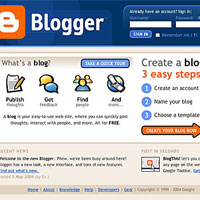- About Us
- Columns
- Letters
- Cartoons
- The Udder Limits
- Archives
- Ezy Reading Archive
- 2024 Cud Archives
- 2023 Cud Archives
- 2022 Cud Archives
- 2021 Cud Archives
- 2020 Cud Archives
- 2015-2019
- 2010-2014
- 2004-2009
 |
Narcissus 2.0: Monetizing User Generated Content |
On the surface of it, User Generated Content (UGC) seems to be an appalling phenomenon – a perverse new millennium hybrid of Funniest Home Videos and schoolgirl diaries.
 However horrible it may seem to the three dozen internet users around the world with a sense of taste, it is a phenomenon that is here to stay.
However horrible it may seem to the three dozen internet users around the world with a sense of taste, it is a phenomenon that is here to stay.
So is this trend restricted to just the internet and traditional media? No, I tend to view it as symptomatic of a far broader global trending away from authority voices… A shift towards the individual as superstar and expert commentator all rolled into one. What elevates UGC above the level of schoolgirl diaries and Super 8 footage of your fat aunt falling over at a family barbecue is its connectivity. This is the key to effectively monetizing it. The two categories that will likely prove to be the most lucrative in the longer term are
- Social Networking
- Content Sharing (blogs, vlogs, etc)
We need to leverage the connections that come along with UGC, rather than scurrying around trying to work out if there is any money to be made in flogging off that footage of your aunt. Start thinking of it as User Generated Connections and you will be laughing.
Social Networking
So is social networking a new phenomenon? Hardly. We built malls and teenagers flocked to them. We built social networking sites and teenagers flocked to them. There appears to be an almost biological drive among adolescents to build identities in a branded, semi-subversive environment. Call it a modern day vision quest. Actually, the tribal reference stands up to closer scrutiny: Ugg goes into the forest and returns with a bear totem and tattoo, branding himself thusly and securing a place in the tribe. Doug goes into the mall and returns with Adidas sweats. Same results.
This need to form identities in branded environments is how you can best monetize social networking. In the short term, Myspace is not going to make for itself anywhere near the amount of money it is going to make for savvy marketers. Compare the selling of display banners to going viral and making full use of tens of millions of connected teenagers. Myspace’s recent Franz Ferdinand experiments bear witness to the effectiveness of this technique: creating community and perceived exclusivity.
The company I work for acquired a glossy teen magazine last year. The website already hosts an editor’s blog. Now, what would happen if we moved the blog over to Myspace, devoted a couple of pages to the site (not that well known in New Zealand but what do you honestly expect), got regular readers to start pages, linked them all together in a friends list, got them to invite their friends… Bam! The editor and the sales manager have twenty four hour access to a rapidly growing, savvy readership. There can be Myspace/magazine cross over competitions, you can give editorial heads up, offer product suggestions, drive traffic to the magazine’s own website (banner revenue goes up)… And it is all free! The long term benefits simply cannot be calculated. Nothing promotes brand loyalty like readers feeling as though they are part of the product, feeling connected (there’s that word again) to the editorial staff.
Is that not better than hysterical marketers bleating over the unfiltered content on the site and whether or not they want their brand bannered over a child predator’s online lair? We need to stop trying to mash our absurd billboards on top of every new innovation and instead work with the possibilities they open up. And let’s be honest, child predators notwithstanding, the majority of social networking pages are hideous early-nineties throwbacks to the days of automatically launched midis and unsigned guest books. Do you want a banner on top of that? Why are we endlessly debating over ways to filter the content to make it palatable to advertisers? Let Fox sort that out for themselves. We just need to make use of this connective power before they find a way to charge for it.
Sharing UGC: Blogging
Sorry to disappoint the naysaying journalists out there but blogging is not a fad. It too, is a symptom. Blogging is further evidence of the social trends I mentioned at the beginning of the article –the individual as both interesting and authoritative.
Blogging as we know it was ideal for the previous broadband/narrowband environment. You could still blog and read blogs with a dial up connection. Given the technology available it was the best way for an internet user to become the broadcaster, to deliver content.
 What will blogging turn into next, once broadband penetration reaches higher and higher? It is anybody’s guess. My crystal ball says the classic text/links/images combo will remain the default post but viewers will cease to be surprised if their RSS feed gives them a default post one morning, a video blog the next and an audio podcast the morning after that –all from the same blogger.
What will blogging turn into next, once broadband penetration reaches higher and higher? It is anybody’s guess. My crystal ball says the classic text/links/images combo will remain the default post but viewers will cease to be surprised if their RSS feed gives them a default post one morning, a video blog the next and an audio podcast the morning after that –all from the same blogger.
So how does one monetize the growing blogging trend? Honestly, it feels like I have been answering this question since the dawn of man. Some newspapers are finally doing it right. Incorporating expert blog content into their print product is fine and lends an air of legitimacy to the blogosphere (which I find ironic) but the real money is to be made by taking the above Myspace teen magazine approach and adapting it for grown-ups.
Promote interactivity between your editorial staff and your readers. Get them out of their Fourth Estate towers and make them actually talk to the subscribers. The blog approach may in fact be newspapers’ salvation against the looming tide of Google News and other aggregators. It offers the opportunity to connect with other humans that Google bots (currently?) cannot deliver. It allows traditional newspaper companies a legitimate reason to be online because let me make this clear: There is no such thing as an online newspaper. Just as whales live in the sea and not in space, newspapers do not live online. They live on paper. (The existence of space whales could not be confirmed at the time of publication but sadly the existence of online newspapers is still very much a reality.)
Establish those connections now, while you can. Even if it is every online news portal’s fate to become nothing more than an aggregator –and such things are out of the hands of mere mortals like you or I- if you have established a connection and a brand loyalty then you will still have a viable media product that advertisers will pay for. Whatever news content turns into, and wherever it is produced, end users still have to get it from somewhere and if you have taken the time to nurture those connections then they will get it from you.
Interestingly this approach does not just apply to media companies. You could be the Managing Director of an industrial plastics supplier and you can still leverage blog technology, connective technology, to form a relationship with your clients that will see them continue to choose you in an increasingly overcrowded marketplace. The key to effectively monetizing blogs is this interactivity, this ability to provide connections between the bloggers and their readers. You talk to them and they talk to you.
It saddens me that marketers have missed the point with blogs as much as they have with social networking. Do we put banners over popular blogs? Do we pay bloggers to shill our latest tech products? Go nuts! I am sure both methods will bring some success but you are still not making full use of the technology, you are still stuck in the old four week campaign mindset: We put an advertisement here. We got this much of a result. In five weeks I will have a crude Excel sheet to show you and then we will go for a five hour lunch.
How about this: Send out samples to the more popular tech bloggers, get them to check out your CEO’s or your company manager’s blog and then get your CEO and your sales team out there posting comments, answering questions and being amongst the blogosphere. I guarantee I am paying more attention when the CEO opens up a dialogue on a popular tech blog. (Steve Jobs being a possible exception. Too ubiquitous.) It costs almost nothing.
Once again, the actual long term value lies not in the content or how it is packaged but the fact that it can be delivered to, interact with and be commented on by thousands of users. Connections, people. Say it with me.
Sharing UGC: Video
I remember about ten years ago I received a home made CD of a friend’s wedding in Fiji. (“What an age we live in!”) I watched the jerky, grainy footage, laughed and called them up to talk about it. Though I did not attend the wedding, I immediately felt empathy for the blurry couple –an emotional connection. I thought this was just because they were my friends.
Turns out I was wrong. Thanks must go to YouTube for showing me the error of my ways. Trying to describe this site makes it sound as completely stupid as Myspace sounds: Fat people celebrating their lonely thirtieth birthdays, small dogs starved for attention, teenage gays in Invercargill lip-synching to Madonna (Hi Dan!). Once again it is that connectivity thing. YouTube is another indicator of the biggest shift in social trends for decades: the common man as superstar. And –perhaps more profitably- the superstar as common man.
'The obvious benefit of this media revolution will be what Mr Saffo of the Institute for the Future calls a ‘Cambrian Explosion’ of creativity: a flowering of expressive diversity on the scale of the eponymous proliferation of biological species 530 million years ago. ‘We are entering an age of cultural richness and abundant choice that we’ve never before seen in history. Peer production is the most powerful industrial force of our time,’ says Chris Anderson, editor of Wired magazine…”i
On this site I can watch/comment on/forward heartwarming video of an Indian wedding, complete with eccentric relatives and sumptuous traditional foods without ever having to step inside an arthouse theatre. (Brilliant!) The immediacy of real life in all its disgusting, unfiltered glory is right there on my screen.
 The immense popularity of this site has marketers losing sleep all around the world. They want in but they do not know how to safely profile their brands. Pre-roll is out. IBM would not take kindly to their logo appearing in front of amateur child pornography or footage of a neo Nazi hate crime (that whole area is sensitive enough as it is). Proctor and Gamble are not going to want their products shown before copyrighted material. Display advertising is also a no-go to all but the bravest of brands for largely the same reasons.
The immense popularity of this site has marketers losing sleep all around the world. They want in but they do not know how to safely profile their brands. Pre-roll is out. IBM would not take kindly to their logo appearing in front of amateur child pornography or footage of a neo Nazi hate crime (that whole area is sensitive enough as it is). Proctor and Gamble are not going to want their products shown before copyrighted material. Display advertising is also a no-go to all but the bravest of brands for largely the same reasons.
YouTube will ultimately suffer the same fate as Myspace. There is currently more money to be made by actually using the site than advertising on it. I want to see DV footage of Ozzy Osbourne fumbling with his new Iriver PMP 120. (Maybe he can give me some tips. I just bought one and honestly, I feel like my grandmother when I try to use it.) Superstar as common man. The thinking goes like this. I am on YouTube. Keira Knightley is on YouTube. Keira Knightley and I have a connection. YouTube allows your customers to build a closer, more personal relationship with your brand.
This relationship can be taken too far, however. The notion –admittedly still in its infancy- of user generated advertisements has so far failed to convince me. Not only because the first few attempts have led to the parody commercials proving far more popular but also because it is only going to be relevant to a limited number of brands. Sure, who wouldn’t want to create a Converse advertisement, but is there really much of a demand to create advertisements for Al’s Office Supply Depot? To me it sounds like marketers conceding defeat: they have given up trying to understand their audience and have handed the job of effectively communicating over to them. If they create it then they will like it, right? At least for the interim, it will likely be more prudent to monetize the user generated video world through pathways that are already successful.
In a funny sort of way, YouTube’s unpredictable content –its wild west, uncontrolled feel- is exactly what is going to make it work in your favour. People expect rawness, roughness –they expect what they find there to be unfiltered. This is why Ozzy swearing and fumbling with a new device is actually really good marketing. YouTubers do not want to see three cameras follow a sports star into a McDonald’s restaurant and hear him talk about how much he enjoys the burgers. They will do worse than reject it. They will mock it thousands of times over right around the world. Filtering the content –making it clean enough for conservative brands- will spoil all its effectiveness.
This whole viral marketing thing –especially when it comes to video content- is the most powerful marketing tool in history. It is like owning a pet shark. Manage it right and thousands of people will flock to the lunatic with the pet shark. Manage it wrong and the ‘shark eats arrogant marketer’ video will be in countless millions of inboxes by morning.
Conclusion
We have such a tendency to create buzzwords. Marketers approach User Generated Content like it is some passing trend that we have to capitalize on before the next one comes along. Can we put banners on social networking sites? Can we charge for video? We are misleading ourselves. UGC is a symptom of a massive shift in our demographic. Consumers no longer sit in front of a television with their mouths open, waiting for us to shovel the latest sugared crap down their throats. We have been caught napping. This, more than anything, needs to be driven home.
“As with the media revolution of 1448, the wider implications for society will become visible gradually over a period of decades. With participatory media, the boundaries between audiences and creators become blurred and often invisible. In the words of David Sifry, the founder of Technorati, a search engine for blogs, one-to-many ‘lectures’ (ie, from media companies to their audiences) are transforming into ‘conversations’ among ‘the people formerly known as the audience’. This changes the tone of public discussions. The mainstream media, says David Weinberger, a blogger, author and fellow at Harvard University’s Berkman Centre, ‘don’t get how subversive it is to take institutions and turn them into conversations’. That is because institutions are closed, assume a hierarchy and have trouble admitting fallibility, he says, whereas conversations are open-ended, assume equality and eagerly concede fallibility.’ii
Conversations. I like that. A verbal connection between two or more people. I will tell you the secret of monetizing UGC. Start thinking of it as User Generated Connections and your brands will emerge in this new world safe and sound.
G Preston White is a New Zealand-based freelance writer. He can be contacted via his website and blog. www.prestonwhite.co.nz
i The Economist. “Among the Audience”.Apr 20th. Kluth, Andreas.
ii The Economist. Ibid.
